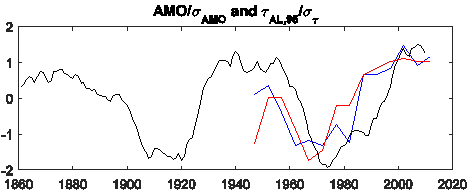

| Home Precipitation River Discharge Sea Level Air Temperature Water Temperature Cloudiness Wind |
Introduction
|
| By examining the distributions of the estimates of the vector component of the wind stress, we show that they are also largest in February-April and smallest in July-September. Binning the vector components during these two intervals for each year, we computed the boundaries of the 95, 90 and 50 percentile intervals, and displayed in the figure to the right, their evolution since 1947. A dramatic decline in the 95 and 80% stress level was detected. In February to April of the 1960-80 interval, the magnitude of the stress during events that were less frequent than 5% was approximately 0.2 Pa. Since 2000 it has been 0.1 Pa. Summer statistics show a similar change. |  (a) shows the boundaries of the stress intervals containing 95% (blue), 80% (green) and 50% (red) of the along LIS component stress estimates in February-April each year. (b) shows the same statistics but for the across LIS stress components. The data distribution evolution for the low wind July-September period are shown in (c) and (d) for the along and across Sound components respectively. |
We should be concerned that trends at a single station might
be the consequence of some local effect. Small movement of sensors or new
buildings can change airflow patterns for example. But the fact that the
reduction in wind speed was regional supports the interpretation that the
climate system is responsible for the change.
The record does not show much decadal-scale variation. The
trends in wind speed and stress show an increase from the 1940s to the 1960s,
and then an almost monotonic decrease. This variation is much more in-keeping
with the form of the Atlantic Multi-decadal Oscillation (AMO) that has been
described by Schlesinger and Ramankutty (1994). The AMO is manifest as
variation in the annual average sea surface temperature in the North Atlantic (30–65°N).
Trenberth and Shea (2006) showed that water temperature (positive AMO) led to
reduced storm activity and it has been linked empirically, and through models,
to several regional ocean and atmosphere trends. For example, above average
summer air temperatures in the eastern United States during positive AMO was
suggested by Enfield et al. (2001), and Goldenberg et al. (2001) found a
positive AMO anomaly was associated with increasing frequency of land-falling
hurricanes on the eastern seaboard.
 The December AMO
index from the NOAA ESRL analysis (black line) with the 95% bounds of the FMA
along Sound stress distributions. The blue shows the lower bound and the red
line is minus the upper bound. All three records have been standardized through
division by the standard deviation. The December AMO
index from the NOAA ESRL analysis (black line) with the 95% bounds of the FMA
along Sound stress distributions. The blue shows the lower bound and the red
line is minus the upper bound. All three records have been standardized through
division by the standard deviation. |
This figure shows the AMO index developed by the NOAA earth Systems Research Laboratory (http://www.esrl.noaa.gov/psd/data/timeseries/AMO/) using satellite sea surface temperature maps. To simplify the graphics, we divide the index by the record standard deviation. The blue lines in (a) of the figure above show the upper and lower value of the along Sound stress component that are greater than 95% of the observations in a particular year. We repeat these lines in the figure to the left after dividing by the standard deviation and changing the sign of the upper (positive) bound. The similarity in the in the pattern of the curves is remarkable. Since the wind records only extend from 1947, less than a single oscillation has been captured. This correspondence can only be further investigated through models |
.
A factor of two change in the stress should be expected to
have a significant effect on the ecosystems of the Sound. Reexamination of data
with the recognition of these long term changes have been occurring may bring
new insights to the understanding of the variability in LIS.
Enfield, D.B.;
Mestas-Nuņez, A.M.; and Trimble, P.J. (2001). The Atlantic Multidecadal
Oscillation and its relation to rainfall and river flows in the continental
U.S.: Geophysical Research Letters, v. 28, p. 2077–2080.
Goldenberg,
S.B., Landsea, C.W., Mestas-Nunez, A.M., and Gray, W.M. (2001). The recent
increase in Atlantic hurricane activity—causes and implications: Science, v.
293, p. 474–479
O’Donnell,
J., H.G. Dam, W.F. Bohlen, W. Fitzgerald, P.S. Gay, A.E. Houk, D.C. Cohen, and
M.M. Howard-Strobel (2008). Intermittent Ventilation in the Hypoxic Zone of
Western Long Island Sound During the Summer of 2004. J. Geophys. Res., 113, doi:10.1029/2007JC004716.
O'Donnell, J. (2010). A Change in the Wind:
Long Term Trends in the Forcing of Long Island Sound. Proceeding of the 2010 Long
Island Sound Research Conference. http://lisfoundation.org/downloads/lisrc_proceedings2010.pdf
O'Donnell, J., R.E. Wilson, K. Lwiza, M. Whitney, W.F.
Bohlen, D. Codiga, T. Fake, D. Fribance, M. Bowman, and J. Varekamp (2014). The
Physical Oceanography of Long Island Sound. In Long Island Sound: Prospects for the Urban Sea. Latimer, J.S.,
Tedesco, M., Swanson, R.L., Yarish, C., Stacey, P., Garza, C. (Eds.), 978-1461461258
Schlesinger,
M.E. and N. Ramankutty (1994): An oscillation in the global climate system of
period 65-70 years. Nature, 367, Issue 6465, pp. 723-726, DOI: 10.1038/367723a0
Trenberth,
K.E. and D.J. Shea (2006): Atlantic hurricanes and natural variability in 2005.
Geophysical Research Letters 33, L12704, doi:10.1029/2006GL026894
Wilson, R.E.,
R.L. Swanson and H.A. Crowley (2008). Perspectives on long-term variations in
hypoxic conditions in Western Long Island Sound. Journal of Geophysical
Research, 113, C12011,
doi:10.1029/2007JC004693.
Wilson, R.E.,
S.D. Bratton, J. Wang and B.A. Colle (2015). Evidence for Directional Wind
Response in Controlling Inter-annual Variations in Duration and Areal Extent of
Summertime Hypoxia in Western Long Island Sound. Estuaries and Coasts (2015)
38:1735–1743 DOI 10.1007/s12237-014-9914-2